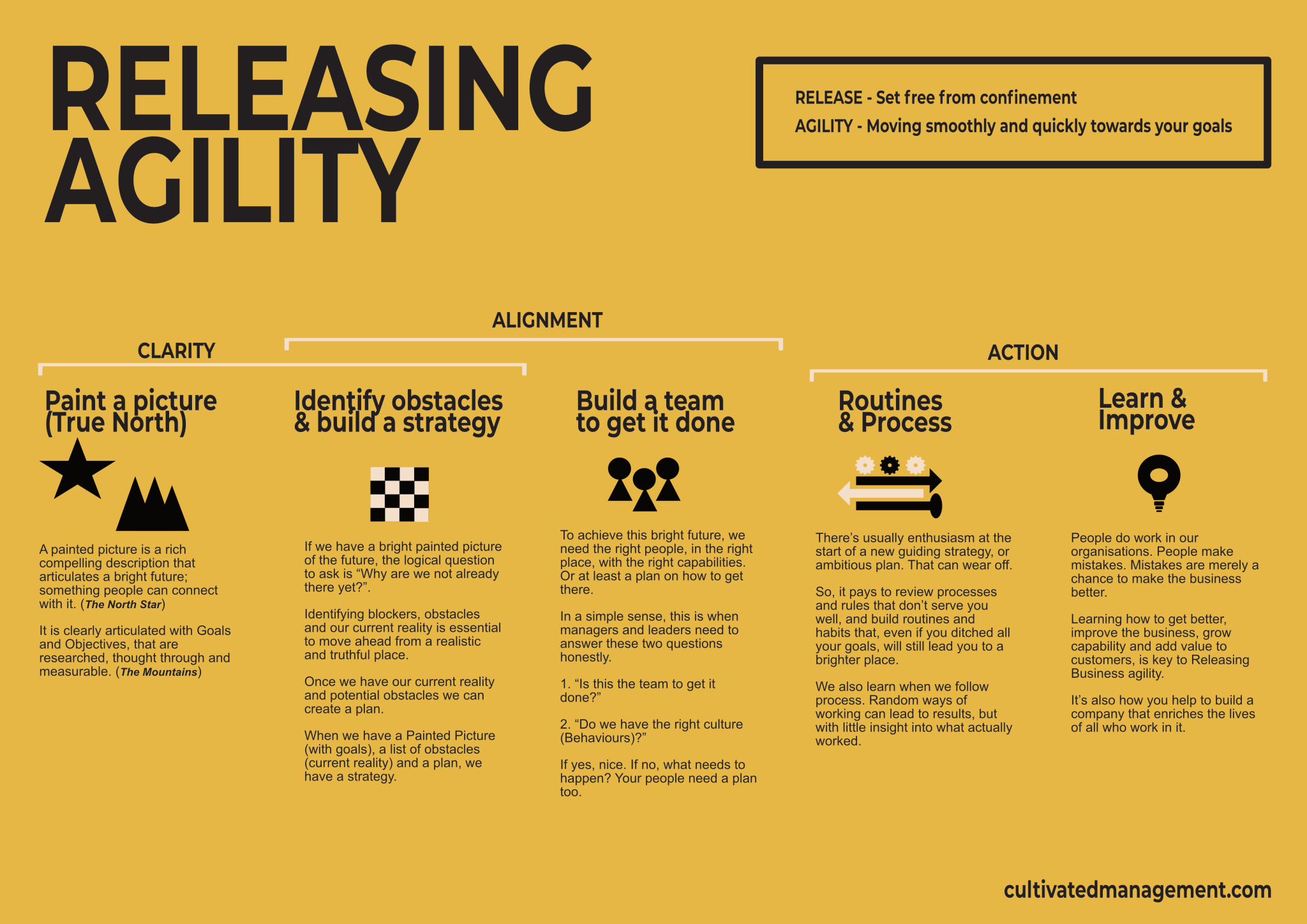Dreamers and Managers - 5 ideas to keep the dreams alive

“The ideal business is composed of managers and dreamers, and it is the responsibility of the former to protect the latter.” --Edwin Land, founder of Polaroid.
I love this quote.
Pretty much every business was created by someone who had a dream. A dream of freedom, or a different lifestyle, or about being their own boss. A dream of changing the world, or serving customers in a different way. Or a dream of grand illusions, or the false pursuit of wealth (those dreams don’t always turn out so well).
And even within your own business you have people who have dreams. Dreams about getting better in what they do, or branching out to set up their own business, or dreams about how to make the business better.
And managers play a critical role in supporting, nurturing and growing those dreams. Or they can squash them.
We need dreamers in business.
Dreaming is how we keep moving forward, inspire others or come up with new products. Dreaming (and bringing dreams to life through creativity) are how we attract talented people to our businesses (and then retain them).
Dreaming is how we bring out people’s natural abilities, creativity and imagination – and help them find meaningful work. Dreaming is how we make the business better.
Yet, in many cases dreams are squashed in the pursuit of financial growth, scale, efficiencies and doing more with less. I took aim at this short sightedness in the Take A Day Off book.
“Imagination and creativity are more useful than aggressiveness” – Paul Hawken, Entrepreneur and Climate activist.
Here are some ideas on how to enable dreamers and keep the dreams alive. And yes, I’ll also cover what to do if you are both a dreamer and a manager.
Understand the dream
I often call this widening your awareness and is one of the 10 behaviours of effective employees. Understand the vision, mission and dream of the business.
If the dream is just to make money, run away.
Why was the business created? What do the founders or directors want?
Understanding the big dreamy painted picture of the business helps you get clarity, and make decisions, and understand how you and your team play a role. It’s the emotional connection to the business.
If you don’t yet have a painted picture (or dream) for your team, spend some time creating one. It’s the first critical step in business – to understand the True North, painted picture or dream. Otherwise, how will you be able to galvanise people when the work gets tough and tedious?
I call the painted picture/dream/True North, the emotional aspect of business. The “why” as some may say. Without it you’ll struggle to inspire, rally and direct any meaningful collective action.

Hire Dreamers
Hiring is the most important aspect of your role as a manager. Everybody you hire adds or detracts from the culture/society you are trying to build. Every person is someone you will have to work with. And if you get it wrong you make your life as a manager insanely hard.
Take your time to hire the right people – and make sure everyone you hire has the ability and desire to dream.
Hire people who believe in something bigger than just their own pockets. Hire people who have ambition and keenness to learn. Hire people who dream and share the general vision of the business. Hire people who can think big. Hire people who care about something.
I have a book on the process I use for hiring and onboarding people called Join Our Company.
Remove Blockers
It amazes me that companies hire in armies of agile specialists to “go agile” when this is what managers should be doing.
Regular readers will spot the first step of my Releasing Agility model is painting a bright future (dreaming). The second step is asking “If this bright future is so compelling and exciting, why are we not already there yet?”. And this leads us to blockers and problems.
If we know where we are going, then we must deal with the blockers and problems that are preventing us from achieving this bright future. And this is the domain of managers.
Let’s be clear here. Most of the problems that dreamers face are created by managers. Red tape, lack of trust, misdirection, low performing team members, poor role modelling and on and on.
So, it takes a self reflecting and humble leader/manager to accept that the very problems that need solving were likely created by themselves in the first place.
Fixing systemic problems is the domain of managers – fixing and removing blockers to get great work done. This also happens to be how you Release Agility and get better business results. It also happens to be how you create great workplaces – by removing the friction that stops people bringing their best self to work.
Managers are in a perfect place to solve many problems.
Remember though, there are always more problems in business than we could ever solve – which is why you need to know the dream (painted picture) – and solve only the problems that are stopping you and your team from achieving this dream.
Agility is about moving smoothly and quickly towards your business goals – and managers have levers to pull – many of them. Check out this video on Levers to pull in business.
Carve out slack
Many managers and leaders keep piling on work. Do more with less. Do more – full stop.
However, when you fill the system of work to capacity there is no room for slack – and very little actually gets done. You leave no room for dreaming. No room for downtime. No room to breathe. No room for innovation or critical thinking. It’s hell.
I always use the analogy of the M25 motorway here in the UK when explaining slack and flow. The M25 circles London and when it’s filled to capacity (or even close) nobody is going anywhere.
So, they have measures to try to address this. Variable speeds to slow down traffic heading towards a jam, filter lanes that allow a small amount of cars on when appropriate and systems monitoring the flow of traffic.
They slow cars down to try and achieve flow. You may move more slowly than the speed limit, but you’re getting somewhere and the system has slack to cater for unexpected events. It doesn’t get jammed as often.
It doesn’t always work but the idea is sound. And we need this in work.
If everyone is packed solid with work and the system is heaving, very little gets delivered, or if it does, it’s usually of poor quality. Then it comes back in to be reworked and the system creaks more.
When pushed to capacity people work more hours or burn out. Or they start breaking protocol, or lying, or misrepresenting the reality of progress. Or they start cheating, or being overly protective. Or quiet quitting. Let’s just say – when people are overwhelmed with work, you’ll see some funky behaviours.
When the system is full of work and people have no time to breathe, there will be no room for innovation, or creativity, or dreaming. It’s also highly likely people will lose sight of the dream as they try to deal with an ever growing amount of work.
However you do it, a manager’s role is to protect the dreamers by trying to find levers to pull to create flow of work, and slack in the system. Uninformed leaders will cry that we’re leaving productivity hours and energy on the table if people aren’t fully stacked 40 hours a week.
I disagree. Slack gives people space to dream, to think, to create – and from this slack time I ALWAYS see improvements that enhance the bottom line or improve wellbeing.
You cannot fill a system with work and expect people to dream and be creative. Yet many managers do this – and wonder why the competition is more innovative (and stealing all of your best employees).
Working ON the system is the job of managers. And that work should be directed to making the system better, more resilient and more effective, therefore allowing people to be more creative. And to dream.
Create Creative Spaces
In a physical office it’s good to have a room that serves the purpose of providing a safe space for creativity, dreaming and innovating.
When we are HERE, in this room, we create and innovate.
It primes the brain and associates a space with the behaviour of dreaming. It’s a powerful environmental affordance technique I use in my own life too. I even built a studio to get this space.
In the virtual world you could create a regular meeting cadence that is only for dreaming – and protect that space. No work updates or “talking shop”. Just innovation and dreaming. Use tools like Mural to provide a blank-canvas creative-space. Set some rules and constraints – constraints (that are well thought out) breed creativity.
Build routines and habits
Any creative endeavour, whether writing a book, or building dreams in business, will require good habits and routines.
Routines take away thinking about process and schedule and agenda – the low level stuff that often gets too much attention in work – often at the expense of actually getting anything meaningful done.
Routines help people to do the work. When the initial burst of enthusiasm wanes, routines can help people keep going.
Habits and routines are what gets things done but they require careful attention.
Managers are well placed to help people build these routines, to remove blockers and to stay out of the way (i.e don’t book managerial type meetings when people are trying to get deep work done).
Managers can clear the decks of low value work, invest in automating tedious stuff and encourage people to stop doing low value activities (like reporting that nobody uses). Managers can align across teams and ensure that space is created for good routines to develop – and space to dream.
Energy and attention are being constantly bombarded in work. Managers can help by removing a lot of the noise and distractive work.
Be a dreamer
And lastly, being a manager and a dreamer are not mutually exclusive. You can be both. I am.
What’s your dream? How often do you carve out space and time to dream? How well do you communicate your dream? How often do you revisit your routines and habits to see if they are helping you?
Dreaming is essential in business and managers can protect people, release business agility and support in removing the dross at work, to allow dreaming to happen.
That’s a manager’s job – to allow everyone in the business to dream, innovate and bring those dreams to life through right action delivering value. And this includes your own dreaming.
In a sense, a manager’s job is to keep the dream alive – and to deliver the value that the dream brings.
Managers are perfectly placed to pull many levers of change to ensure the dreamers in a business don’t lose their creative edge. Dreaming and imagination and creativity will keep a business alive – but only if they can be unleashed, harnessed, protected and delivered.
And that’s why I love management so much – we’re in a perfect position to nudge the business forward. We’re in a perfect position to hire people who care and who can think – and then help them to make the business better through their dreams.